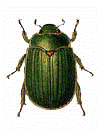Museum, University of Nebraska State
Date of this Version
July 2007
Abstract
The subtribe Anisopliina (Scarabaeidae: Rutelinae: Anomalini) is associated with grasses, and its species are distributed in the Palaearctic, Oriental, Ethiopian, Nearctic and Neotropical biogeographical regions. Phylogenetic analysis of adult morphological characters was conducted to examine the monophyly and classification of the group, as well as to examine characters associated with grass pollinivory and graminivory. We review the biology, phylogeny and classification of the Anisopliina and provide an overview of each genus. The analysis of ninety-one morphological characters using parsimony does not support the monophyly of the subtribe Anisopliina. Instead, the results provide support for a group referred to here as the anisopliine clade, a circum-Mediterranean group, forming an internal clade within the well-supported tribe Anomalini. Sister group relationships are discussed, possibly being associated with a New World anomaline taxon. Character states associated with grass herbivory, including mouthpart and leg characters, are discussed based on the phylogenetic analysis. Within the Anomalini, an evolutionary shift from generalized leaf feeding to grass associations and grass pollen feeding is supported.


Comments
Published in Systematic Entomology 32:3 (July 2007), pp. 429–449; doi:10.1111/j.1365-3113.2006.00380.x. Copyright © 2007 Mary Liz Jameson, Estefania Micó, and Eduardo Galante. Journal compilation copyright © 2007 The Royal Entomological Society. Published by Blackwell Publishing. Used by permission.